Exploring the Intricacies of Histology and Cytology: Unveiling the Hidden World of Cells and Tissues
Histology and cytology are two remarkable branches of biological science that delve deep into the microscopic universe of cells and tissues. These disciplines play a pivotal role in unraveling the mysteries of life, aiding in diagnosis, research, and our understanding of the intricate machinery that powers our bodies. In this blog, we embark on a journey to explore the captivating realms of histology and cytology, shedding light on their significance, techniques, and how they shape modern medicine.
Histology: Peering into the Architectural Wonders of Tissues
Histology, often referred to as microscopic anatomy, involves the study of tissues at a microscopic level. Tissues are groups of specialized cells that work in harmony to perform specific functions. Through histological techniques, scientists can examine the arrangement, structure, and composition of different tissue types, unlocking insights into their roles within the body.
The field of histology has undergone remarkable advancements, with techniques such as staining, microscopy, and molecular biology tools enabling researchers to visualize tissues with unprecedented clarity. Hematoxylin and eosin staining, for instance, imparts distinct colors to different cell components, aiding in the identification of abnormalities. Immunohistochemistry utilizes antibodies to highlight specific proteins, offering insights into cellular activities and disease markers.
Cytology: Decoding the Cellular Wonderland
Cytology, on the other hand, focuses on the study of individual cells – the fundamental units of life. By examining cell structure, function, and interactions, cytologists contribute extensively to cancer diagnosis, prenatal screenings, and the understanding of cellular processes. One of the most iconic cytological tools is the Pap smear, revolutionizing the early detection of cervical cancer.
Emerging technologies like flow cytometry empower researchers to analyze thousands of cells per second, providing a deeper understanding of cell populations and their characteristics. Moreover, the advent of single-cell sequencing has unveiled the heterogeneity within tissues, unraveling new dimensions of cellular diversity.
The Marriage of Histology and Cytology in Medicine
Histology and cytology jointly play a pivotal role in modern medicine. Biopsies, which involve the removal and examination of tissue samples, aid in diagnosing various diseases and conditions. These techniques enable pathologists to identify abnormalities, such as cancerous cells or tissue damage, guiding clinicians in determining suitable treatments.
In cancer research, histology and cytology are instrumental in understanding tumor biology. By analyzing cancer cells' appearance and behavior, researchers can devise targeted therapies, enhancing treatment efficacy. Additionally, these fields contribute to organ transplantation, as histocompatibility testing ensures compatibility between donors and recipients.
Challenges and Future Directions
Despite their monumental contributions, histology and cytology face challenges. Variability in sample preparation, staining techniques, and interpretation can introduce errors. Automation and digitalization have stepped in to mitigate these concerns, allowing for standardized procedures and digital image analysis.
Looking ahead, the integration of artificial intelligence and machine learning holds immense promise. These technologies can expedite the analysis of vast amounts of histological and cytological data, potentially revolutionizing disease diagnosis and personalized medicine.
In conclusion, histology and cytology stand as pillars of scientific discovery, enabling us to peer into the intricate world of cells and tissues. Their contributions to medical diagnostics, research, and treatment are immeasurable. As technology marches forward, these fields continue to evolve, promising a future where we unravel even more of life's enigmatic tapestry. So, the next time you gaze upon a histological slide or delve into cytological research, remember the hidden wonders they unveil.
